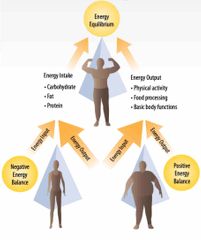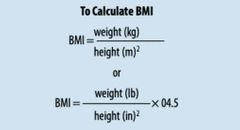![]()
![]()
![]()
Use LEFT and RIGHT arrow keys to navigate between flashcards;
Use UP and DOWN arrow keys to flip the card;
H to show hint;
A reads text to speech;
26 Cards in this Set
- Front
- Back
|
Energy Intake |
The caloric or energy content of food provided by the sources of dietary content. |
|
|
How many calories are there per gram of carbohydrate, protein, fat, and alcohol? |
Carbohydrates: 4 kcal / g Protein: 4 kcal /g Fat: 9 kcal / g Alcohol: 7 kcal / g |
|
|
Energy output |
The use of calories or energy for basic body functions, physical activity, and processing of consumed foods. |
|
|
Energy balance |

The balance between amounts of energy consumed and expended. |
|
|
Satiety |
The effects of a food or meal that delay subsequent intake. A feeling of satisfaction and fullness following eating that quells the desire for food |
|
|
Total metabolic rate |
The total of the resting energy expenditure, energy used in physical activity, and energy used in processing food; usually expressed in kilocalories per day. |
|
|
Basal Metabolic Rate |
A clinical measure of resting energy expenditure performed upon awakening, 10 -12 hours after eating, and 12 – 18 hours after significant physical activity. |
|
|
Lean body mass |
The portion of the body exclusive of stored fat, including muscle, bone, connective tissue, organs, and water. |
|
|
Calorimetry |
The measurement of the amount of heat given off by an organism. Used to determine total energy expenditure |
|
|
Body composition |
The chemical or anatomical composition of the body. Commonly defined as the proportions of fat, muscle, bone, and other tissues in the body |
|
|
Body mass index (BMI) |
Body weight (in kilograms) divided by the square of height (in meters). |
|
|
For most people, most of one’s total metabolic rate/energy expenditure is… |
Basal |
|
|
Major diseases where risk is increased by overweight and obesity |
- Cancers of the esophagus, colon, rectum, uterus, kidney, pancreas, thyroid, and gallbladder. - Postmenopausal women is also linked to breast cancer |
|
|
Weight management goals should be… |
things you can control, such as how long you run on a treadmill and not results, such as level of body fat |
|
|
Which type of foods have a relatively higher or lower satiety value than others? |
- Protein consumption increases satiety more than eating fats or carbohydrates - Adding fiber to low-energy-dense foods can have a higher satiety - Simple carbohydrates and added sugars have a low satiety value - Liquid foods are less satiating than solid foods |
|
|
Explain why digesting, absorbing, & metabolizing food increases your metabolic rate |
Our bodies use energy to digest, absorb, and metabolize the nutrients we take in, and these processes generate heat. |
|
|
What does indirect calorimetry measures, why is it a good approximation of energy expenditure? |
Energy expenditure is estimated from a person’s oxygen consumption and carbon dioxide production |
|
|
Limitations of BMI measurements |
- Does not tell you enough about whether you are carrying muscle weight or excess fat - BMI can underestimate health risks associated with excess body fat |
|
|
The role of body fat distribution in overall disease risk |
- Risk of chronic disease rises dramatically when body fat exceeds these levels: o Females – 20 to 35% body fat (normal amount) o Males – 8 to 24% body fat (normal amount) - Excess abdominal fat is linked to high blood lipids, glucose intolerance, insulin resistance, high blood pressure, increases risk of heart disease and diabetes mellitus. Increased breast cancer risk for women. - A waist circumference greater than 40 inches in men and 35 inches in women is a sign of increased health risk. |
|
|
Pros and cons of gastric surgery for long-term weight loss |
Pros: - Lose more wight initially than those who try diet and exercise Cons: - Absorption of micronutrients is reduced - Reduces digestion and absorption of caloric foods |
|
|
Some factors that may lead to an individual eating more food at a meal |
- A large serving size - Sensory properties: flavor, texture, color, temperature, and presentation influence the foods appeal - Environmental / social factors - Emotional factors - Hormonal factors |
|
|
Some factors that cause individual variation in basal / metabolic rate |
- A muscular person with a large lean body bass has a higher metabolic rate than an obese person with the same weight - Age, gender, degree of muscle development, body size all influence a person’s lean body mass. |
|
|
Calculating a BMI from a person’s height and weight and categorize that BMI as underweight, normal, overweight or obese |

Underweight: BMI less than 18.5 kg/m2 Normal weight: greater than 18.5 kg /m2 but less than 25 kg/m2 Obesity: BMI at or above 30 kg/m2 Overweight: BMI at or above 25 kg/m2 and less than 30 kg/m2 |
|
|
Explain factors that cause individual variation in obesity |
- Biological: Hormones can influence eating behaviors through their direct or indirect effects on the brain. - Social / environmental: We tend to eat more in cold weather and less in hot weather. o In cold temperatures, increased food intake helps us survive by supporting an increased metabolic rate, which helps generate heat, and an increase in fat stores, which provide insulation to reduce heat loss. - Lifestyle / behavior: People use food to cope with stress and negative feelings. Binge eating and other eating patterns can develop. |
|
|
Explain why “overall behavior change” is preferable to “dieting” for long-term weight management, as well as what behaviors are recommended, in general |
Most weight problems are lifestyle problems. Many young adults develop terrible eating habits with a lack of exercise which can result in an unhealthy lifestyle. Rather than dieting people who have long-term success share common behavioral strategies that include eating a diet low in fat, frequent self-monitoring of body weight and food intake, and high levels of regular physical activity. |
|
|
The likely effectiveness of a diet plan (as presented e.g. on a web site or in a self-help book) for weight loss |
- Some people respond well to information provided in easy-to-understand format. o Can help change behavior by referring to good, well researched self-help manuals and books. |

